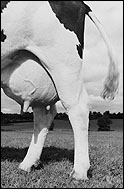Udder despair
Here's another reason to fear E. coli.
Every year, E. coli, along with certain other bacteria, costs the Canadian dairy industry an estimated $200 million in lost milk production, bovine medical treatment and culling of herds. Infections of cows may also hurt public confidence in the industry, particularly due to health concerns related to antibiotic treatments of milk-producing cows.
 E. coli and other bacteria that cause mastitis in cows cost the Canadian dairy industry $200 million in lost milk production and treatments
E. coli and other bacteria that cause mastitis in cows cost the Canadian dairy industry $200 million in lost milk production and treatments |
|
For the first time, in a paper published in a recent issue of the journal Cell Death and Differentiation, a McGill researcher and his collaborators have shown how the pernicious bacterium does the damage.
"We showed that mastitis, inflammation of the mammary gland due to infection of bacteria like E. coli, triggers the death of milk-producing cells in cow udders," says Professor Xin Zhao, chair of the Department of Animal Sciences, which is located at the Macdonald Campus.
"This was suspected, but so far there was little or no evidence to show that. To our knowledge, our study is the first to prove that E. coli causes apoptosis, which is programmed cell death.
"After determining that, we wanted to know how this happens -- so we looked at the different signalling pathways leading to cell death." They found that E. coli triggers apoptosis by inducing mammary cells to produce enzymes that digest the cell's extracellular matrix, a protective membrane. The bacteria's presence also sets off other cellular chain reactions that set the stage for cell death.
The study, which was conducted by a graduate student in Zhao's lab, Ezhou Long, in collaboration with researchers from the United States Department of Agriculture, also yielded a surprise. They found that mastitis also indirectly triggers cell division in the udder, the opposite response to cell death.
"That was something we were not expecting to see; the mammary gland tries to compensate for the loss of cells through increased cell division. Unfortunately, it's not enough, and the cell death outraces the proliferation of new cells."
Zhao's team has no plans to pursue that avenue, but he expects that other researchers may run with it and develop ways of stimulating cell proliferation. Growth hormones would be a possibility, although this approach has not been approved in Canada.
The next step for Zhao's lab is to look for compounds which can interfere with the process of apoptosis, and some of the harmful by-products of infection, like free radicals.
"Free radicals result from the cow's immune response to infection, and can cause further damage to the cells. We are testing chemicals in-vitro [in the lab] for neutralizing free radicals before trying them in-vivo [within the cows themselves]."
Zhao and his collaborators are also pursuing another promising area of follow-up research: a project to find the gene or genes which, in a sub-group of cows, are responsible for resistance to mastitis.
"We are trying to further identify pathways from the bacteria to the eventual cell death. Why do some cows get mastitis and some don't? Most likely it's because of their differing gene expression. Once we identify what genes give resistance, these can be used as selection markers for animal breeding purposes." Zhao says that selective breeding of cows with resistance genes to mastitis could produce healthier offspring and may reduce the need for later treatment or culling.
The research is sponsored by the Natural Sciences and Engineering Research Council and the Fonds pour la Formation de Chercheurs et l'Aide à la Recherche.

